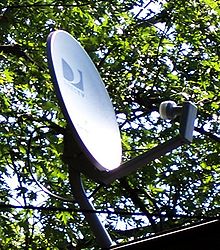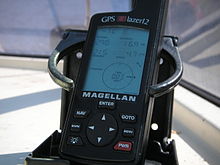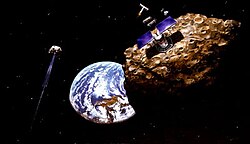A DIRECTV satellite dish on a roof
Commercial use of space is the provision of goods or services of commercial value by using equipment sent into Earth orbit or outer space. Examples of the commercial use of space include satellite navigation, satellite television and commercial satellite imagery. Operators of such services typically contract the manufacturing of satellites and their launch to private or public companies, which form an integral part of the space economy. Some commercial ventures have long-terms plans to exploit natural resources originating outside Earth, for example asteroid mining. Space tourism, currently an exceptional activity, could also be an area of future growth, as new businesses strive to reduce the costs and risks of human spaceflight.
The first commercial use of outer space occurred in 1962, when the Telstar 1 satellite was launched to transmit television signals over the Atlantic Ocean. By 2004, global investment in all space sectors was estimated to be $50.8 billion. As of 2010, 31% of all space launches were commercial.
History
The first commercial use of satellites may have been the Telstar 1 satellite, launched in 1962, which was the first privately sponsored space launch, funded by AT&T and Bell Telephone Laboratories. Telstar 1 was capable of relaying television signals across the Atlantic Ocean, and was the first satellite to transmit live television, telephone, fax, and other data signals. Two years later, the Hughes Aircraft Company developed the Syncom 3 satellite, a geosynchronous communications satellite, leased to the Department of Defense. Commercial possibilities of satellites were further realized when the Syncom 3, orbiting near the International Date Line, was used to telecast the 1964 Olympic Games from Tokyo to the United States.Between 1960 and 1966, NASA launched a series of early weather satellites known as Television Infrared Observation Satellites (TIROS). These satellites greatly advanced meteorology worldwide, as satellite imagery was used for better forecasting, for both public and commercial interests.
On April 6, 1965, the Hughes Aircraft Company placed the Intelsat I communications satellite geosynchronous orbit over the Atlantic Ocean. Intelsat I was built for the Communications Satellite Corporation (COMSAT), and demonstrated that satellite-based communication was commercially feasible. Intelsat I allowed for near-instantaneous contact between Europe and North America by handling television, telephone and fax transmissions. Two years later, the Soviet Union launched the Orbita satellite, which provided television signals across Russia, and started the first national satellite television network. Similarly, the 1972 Anik A satellite, launched by Telesat Canada, allowed the Canadian Broadcasting Corporation to reach northern Canada for the first time.
Beginning in 1997, Iridium Communications began launching a series of satellites known as the Iridium satellite constellation, which provided the first satellites for direct satellite telephone service.
Space transportation
Delta IV Medium launch carrying DSCS III-B6
The commercial space transportation industry derives the bulk of its revenue from the launching of satellites into the Earth’s orbit. Commercial launch providers typically place private and government satellites into low Earth orbit (LEO) and geosynchronous Earth orbit (GEO). In 2002, commercial space transportation generated 6.6 billion dollars, which made up 6% of the total gross of commercial space activities.
The Federal Aviation Administration (FAA) has licensed four commercial spaceports in the United States: the Virginia Space Flight Center/Wallops Flight Facility, Kodiak Launch Complex, Spaceport Florida/Kennedy Space Center/Cape Canaveral Air Force Station, and the California Spaceport/Vandenberg AFB. Launch sites within Russia and China have added to the global commercial launch capacity. The Delta IV and Atlas V family of launch vehicles are made available for commercial ventures for the United States, while Russia promotes eight families of vehicles. The three largest Russian systems are the Proton, Soyuz, and Zenit.
Between 1996 and 2002, 245 launches were made for commercial ventures while government (non-classified) launches only total 167 for the same period. Commercial space flight has spurred investment into the development of an efficient reusable launch vehicle (RLV) which can place larger payloads into orbit. Several companies such as SpaceX and Blue Origin are currently developing new RLV designs.
In the United States, Office of Commercial Space Transportation (generally referred to as FAA/AST or simply AST) is the branch of Federal Aviation Administration (FAA) that approves any commercial rocket launch operations—that is, any launches that are not classified as model, amateur, or "by and for the government."
Satellites and equipment
- Satellite manufacturing
- Ground equipment manufacturing
- Transponder leasing
Subscription satellite services
In 1994, DirecTV debuted direct broadcast satellite by introducing a signal receiving dish 18inches in diameter. In 1996, Astro started in Malaysia with the launch of the MEASAT satellite. In November 1999, the Satellite Home Viewer Improvement Act became law, and local stations were then made available in satellite channel packages, fueling the industry’s growth in the years that followed. By the end of 2000, DTH subscriptions totaled over 67 million.Satellite radio was pioneered by XM Satellite Radio and Sirius Satellite Radio. XM’s first satellite was launched on March 18, 2001 and its second on May 8, 2001. Its first broadcast occurred on September 25, 2001, nearly four months before Sirius. Sirius launched the initial phase of its service in four cities on February 14, 2002, expanding to the rest of the contiguous United States on July 1, 2002. The two companies spent over $3 billion combined to develop satellite radio technology, build and launch the satellites, and for various other business expenses.
Satellite imagery
Several operators of Earth observation satellites, such as GeoEye and Spot Image, provide images commercially.
Magellan GPS receiver in a marine application.
A satellite navigation system is a system of satellites that provide autonomous geo-spatial positioning with global coverage. It allows small electronic receivers to determine their location (longitude, latitude, and altitude/elevation) to high precision (within a few metres) using time signals transmitted along a line of sight by radio from satellites. The signals also allow the electronic receivers to calculate the current local time to high precision, which allows time synchronisation. A satellite navigation system with global coverage may be termed a global navigation satellite system (GNSS).
Space tourism
Space tourism is space travel by individuals for the purpose of personal pleasure. The space tourism industry is being targeted by spaceports in numerous locations, including the Mojave Air and Space Port in California, the Clinton-Sherman Industrial Airpark near Burns Flat, Oklahoma Spaceport America in Sierra County, New Mexico, the Mid-Atlantic Regional Spaceport on the Delmarva Peninsula in Virginia, the Kodiak Launch Complex on Kodiak Island, Alaska, and the Esrange Space Center in Kiruna, Sweden.
Commercial recovery of space resources
Artist's concept of asteroid mining
Commercial recovery of space resources is the exploitation of raw materials from asteroids, comets and other space objects, including near-Earth objects. Minerals and volatiles could be mined then used in space for in-situ utilization (e.g. construction materials and rocket propellant) or taken back to Earth. These include gold, iridium, silver, osmium, palladium, platinum, rhenium, rhodium, ruthenium and tungsten for transport back to Earth; iron, cobalt, manganese, molybdenum, nickel, aluminium, and titanium for construction; water and oxygen to sustain astronauts; as well as hydrogen, ammonia, and oxygen for use as rocket propellant.
There are several commercial enterprises working in this field, including Planetary Resources and Deep Space Industries.
Regulation
Beyond the many technological factors that could make space commercialization more widespread, it has been suggested that the lack of private property, the difficulty or inability of individuals in establishing property rights in space, has been an impediment to the development of space for both human habitation and commercial development.Since the advent of space technology in the latter half of the twentieth century, the ownership of property in space has been murky, with strong arguments both for and against. In particular, the making of national territorial claims in outer space and on celestial bodies has been specifically proscribed by the Outer Space Treaty, which had been, as of 2012, ratified by all spacefaring nations.
In November 25, 2015 President Obama signs the U.S. Commercial Space Launch Competitiveness Act (H.R. 2262) into law. The law recognizes the right of U.S. citizens to own space resources they obtain and encourages the commercial exploration and utilization of resources from asteroids. According to the article § 51303 of the law:
A United States citizen engaged in commercial recovery of an asteroid resource or a space resource under this chapter shall be entitled to any asteroid resource or space resource obtained, including to possess, own, transport, use, and sell the asteroid resource or space resource obtained in accordance with applicable law, including the international obligations of the United States





